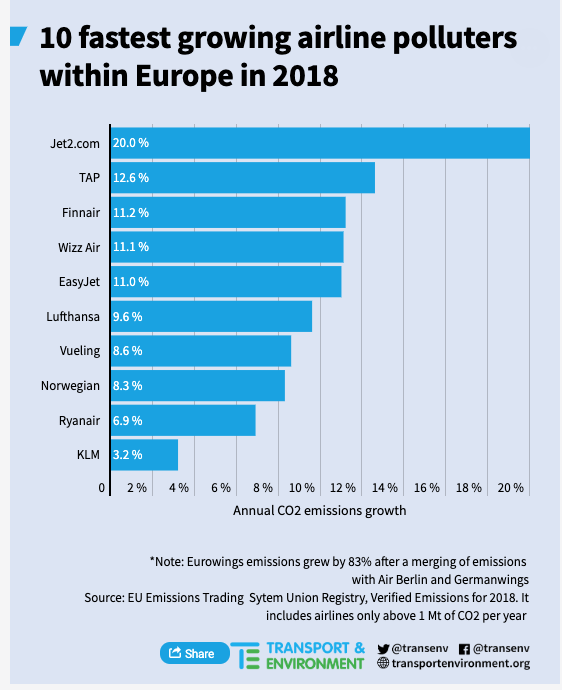Transport & Environment (T&E) says the top 10 growing polluters show that aviation’s runaway emissions are a problem for the whole airline sector, which governments have left untaxed and under-regulated compared to other transport. Emissions from flights within Europe account for only 40% of the problem – the remaining 60% comes from flights to destinations outside Europe and these are entirely unregulated.[2]

See larger size chart at
https://infogram.com/airlines-ets-data_2018-1hnq41y0qmqp43z
Andrew Murphy, aviation manager at T&E, said: “Airlines’ emissions are booming and not just on cheap flights. National carriers and low-cost airlines all benefit from paying no fuel tax and VAT while the rest of us must pay our way. Governments and the EU need to wake up, starting with a tax on kerosene and clean fuel mandates that force airlines to switch to zero-emission jet fuel.”
What’s more, aviation regulators are consistently underestimating the extent of the emissions growth in their planning forecasts. The European Aviation Safety Agency (EASA) anticipated a 3.3% increase in carbon emissions on flights within Europe last year, but official data shows they grew 4.9% – or 1.1 megatonnes of CO2 more than expected.
Rather than taxing and regulating aviation emissions, governments are pursuing a controversial UN offsetting scheme for aviation that will allow aviation emissions to continue growing. There are serious doubts over the environmental effectiveness of carbon offsets. Airlines can emit even more carbon by buying very cheap offsets – where they invest in environmental projects, such as a hydrodam project which later collapsed, instead of reducing their own carbon footprint.
Andrew Murphy said: “It’s no surprise that aviation emissions continue to soar as governments have wasted two decades trying to make offsetting work. It’s now time to call it quits on this failed climate policy, and instead focus on proven measures – taxing kerosene, and ultimately replacing it with zero-emission fuels.”
Notes to editors:
[1] Eurowings’ emissions grew 83% in the same period, however this is largely through merging emissions with Air Berlin and germanwings.
[2] EASA Environment Report, 2019.
https://www.easa.europa.eu/eaer/

See also
Ryanair’s carbon emissions within Europe make it the EU’s 10th largest emitter
Ryanair has become the first non-coal company to join Europe’s top 10 biggest carbon emitters, according to EU ETS figures. That is for flights within the EU. Ryanair declared 9.9 megatonnes of greenhouse gas emissions in 2018, up 6.9% on 2017 and up 49% over the last 5 years. The only larger emitters of carbon within Europe are power stations. Andrew Murphy, the aviation manager at T&E said: “When it comes to climate, Ryanair is the new coal. This trend will only continue until Europe realises that this undertaxed and under-regulated sector needs to be brought into line, starting with a tax on kerosene and the introduction of mandates that force airlines to switch to zero-emission jet fuel.” Emissions from airlines, have risen over 25% since 2014, outpacing all other transport sectors. EasyJet was 31st on the list, after an 11% rise in emissions in 2018. Prof Kevin Anderson at the University of Manchester, said: “Ryanair use new and efficient aircraft rammed to the rafters with passengers, illustrating how technology alone cannot reconcile aviation’s rocketing emissions with the Paris climate commitments…we need to drive down the demand for aviation.”
Click here to view full story…
.
.
.
